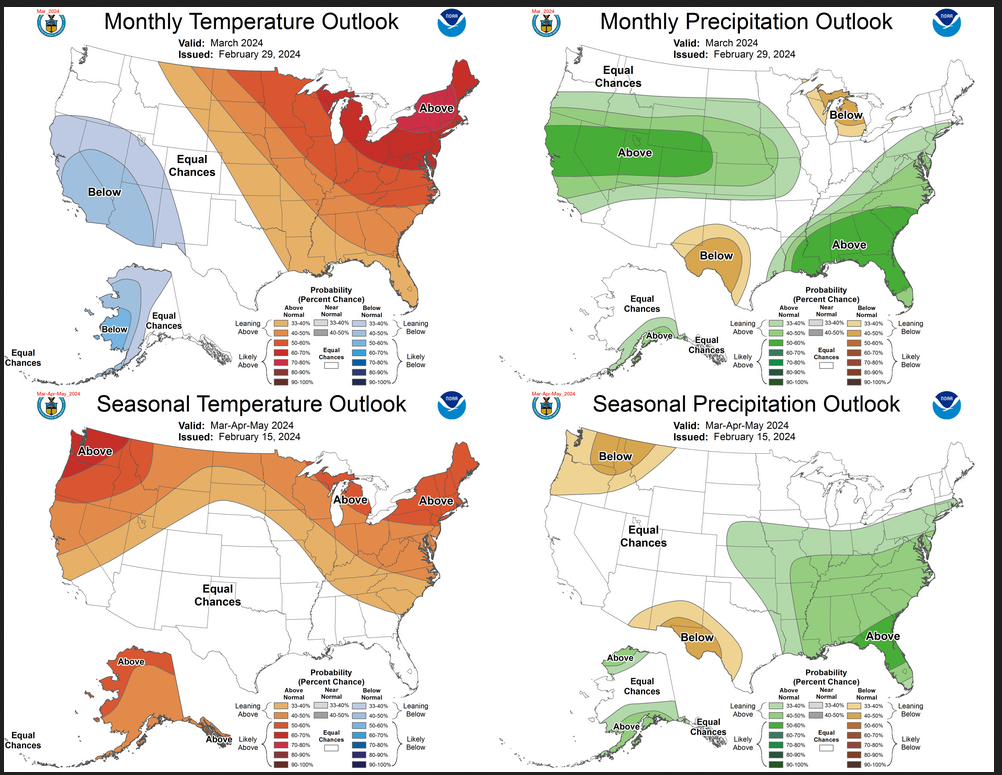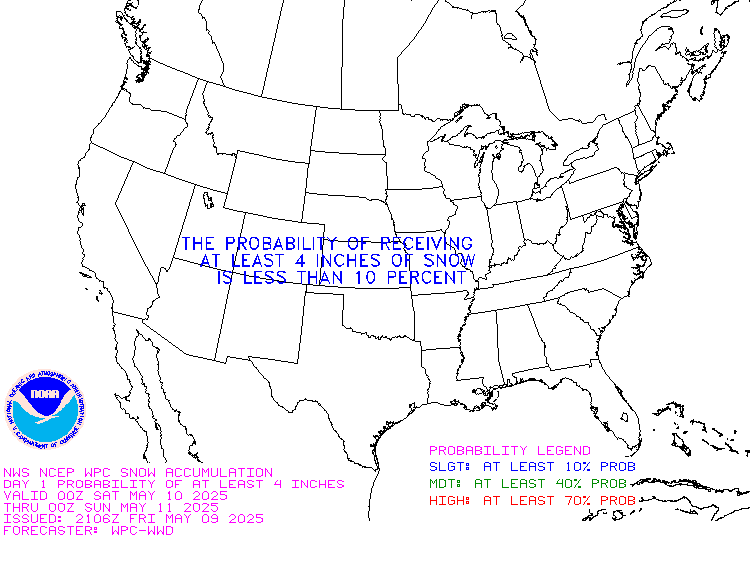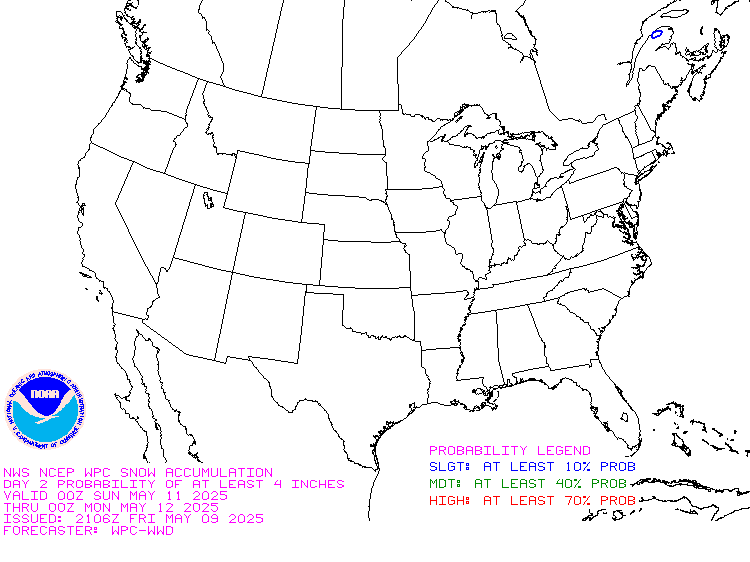It is difficult to find a more comprehensive Weather Outlook anywhere else with the ability to get a local 10-day Forecast also.
This article focuses on what we are paying attention to in the next 48 to 72 hours. The article also includes weather maps for longer-term U.S. outlooks and a six-day World weather outlook which can be very useful for travelers.
First the NWS Short Range Forecast. The afternoon NWS text update can be found here but it is unlikely to have changed very much. The images in this article automatically update.
Short Range Forecast Discussion
NWS Weather Prediction Center College Park MD
300 AM EST Sat Mar 02 2024Valid 12Z Sat Mar 02 2024 – 12Z Mon Mar 04 2024
…Winter storm continues this weekend in the West with heavy mountain
snow, widespread damaging winds, and powerful blizzard conditions in the
Sierra Nevada……Wintry mix for portions of the Northern Plains with some moderate to
locally heavy snow possible……A coastal storm will bring widespread rain up the East Coast through
Saturday……Much above average, Spring-like temperatures expanding from the
Plains/Midwest into the Northeast this weekend with Critical Fire Weather
threat for the central/southern High Plains…A significant winter storm continues to impact much of the West, including
dangerous, blizzard conditions for the Sierra Nevada as an amplifying
upper-level trough forces its way into the western U.S. A multi-day influx
of moisture from the Pacific interacting with colder air pushing southward
from Canada is bringing heavy higher elevation, mountain snows across most
of the ranges of the Pacific Northwest, northern/central California, the
Great Basin, and the northern/central Rockies. There is at least a
moderate chance (40-60% probability) of an additional 12″+ of snowfall
through the end of the weekend. In addition, widespread wind-related
advisories and warnings remain in effect across much of the greater
western U.S. as wind gusts reach upwards of 55 mph, with gusts as high as
75 mph for higher elevations, leading to the risk of downed trees and
power lines. The combination of snow and high winds is most intense in the
Sierra Nevada, where heavy snow rates exceeding 3″ per hour and winds
gusting over 100 mph are causing significant blowing, drifting snow and
whiteout conditions, making travel impossible through the area. The most
intense snow and wind should begin to wind down through the day Sunday.
High temperatures will be below average this weekend with the colder
airmass moving in, with highs in the teens and 20s for the Northern
Rockies; 30s and 40s for the Pacific Northwest, northern California, the
Great Basin, and central Rockies; 50s for central California; and 60s for
southern California. Temperatures will be warmer into the Southwest with
highs in the 70s.Falling heights as the amplifying trough begins to shift eastward over the
northern High Plains will help to deepen/organize a low pressure/frontal
system during the day Saturday. This system is forecast to track east into
the Upper Midwest/Great Lakes Sunday. Limited moisture ahead of the system
will keep precipitation chances rather low. However, in the colder air to
the north/northwest of the system, enough moisture will be in place for a
wintry mix of freezing rain and snow across portions of the Northern
Plains. Some moderate to locally heavy snowfall will be possible along the
Canadian border. Winds will likely also be rather breezy, with the
potential for some blowing snow. To the east, a low pressure/frontal
system lifting up the East Coast will continue to spread showers through
the Mid-Atlantic and into New England Saturday bringing moderate to
locally heavy rainfall, particularly for coastal locations. Some showers
and thunderstorms will remain possible along the frontal boundary
lingering southwestward along the coastal Southeast, Florida, and the
central Gulf Coast. Rain chances will come down overnight Saturday and
into early Sunday as the system pushes eastward away from the coast.Widespread well above average, Spring-like temperatures are forecast to
continue for much of the Plains and Midwest this weekend. The greatest
anomalies will be centered over portions of the central/northern Plains
and Upper Midwest Saturday, spreading into the Great Lakes and Middle
Mississippi/Ohio Valleys on Sunday, where forecast highs reaching well
into the 60s and 70s are upwards of 25-35 degrees above average. Some
highs may tie/break local daily records. Further south, highs will be into
the 70s and 80s for the Southern Plains. Unfortunately, the combination of
these warm temperatures along with gusty winds and dry conditions have
resulted in another Critical Risk of Fire Weather (level 2/3) from the
Storm Prediction Center for portions of the central and southern High
Plains. The warming trend will spread into the Northeast on Sunday
following the departure of the coastal low, with highs warming into the
40s and 50s in New England and the 50s and 60s in the Mid-Atlantic. While
not quite as anomalous, highs across the Southeast into the 60s and 70s
are still running above early March averages.
To get your local forecast plus active alerts and warnings click HERE and enter your city, state or zip code.
Above is a 72 hour animation of the forecast. Learn about wave patterns HERE.
Then, looking at the world and of course, the U.S. shows here also. Today we are looking at precipitation.
In case you missed it, this is the updated forecast for March and how it impacts the three-month Outlook.
Combination of the Updated Outlook for March and the Three-Month Outlook

| The top row is the Updated Outlook for the new month. There is a temperature map and a precipitation map. The second row is a three-month outlook that includes the new month. I think the outlook maps are self-explanatory. What is important to remember is that they show deviations from the current definition of normal which is the period 1991 through 2020. So this is not a forecast of the absolute value of temperature or precipitation but the change from what is defined as normal or to use the technical term climatology. |
Please click on “Read More” below to access the full Daily Report issued today.
| Notices: What would you like to learn about? Please provide that to me via the comment section at the end of the article. |
Now more detail on the 48-Hour Forecast (It is a 48 to 72 Hour Forecast actually)
Daily weather maps. The Day 1 map updates twice a day and the Day 2 and 3 maps update only once a day. These maps update automatically. But if that does not happen, you can get updates by clicking HERE
TODAY (or late in the day the evening/overnight map will appear) (Key to surface fronts shown on maps and you will then also be able to insert a city name or zip code and get a local NWS forecast).
TOMORROW
NEXT DAY
This animation shows how things may play out over the next 60 hours. To update click here.
The NWS Climate Prediction Center’s: Watches, Warnings, and Advisories plus other information can be found HERE. We post at least one of those updates daily, sometimes both. The Highlights are shown in the lede paragraph of this article.
ATMOSPHERIC RIVERS
This tells us what is approaching the West Coast. Click HERE to update If I have not gotten around to doing the update. Here is some useful information about Atmospheric Rivers.
Below is the current five-day cumulative forecast of precipitation (Updates can be found HERE)
Ski SnowReports
New Feature – Ski Reports. It is difficult to find reports that auto-update on-screen (and they are very long) but these links will get you to them – If you have additional suggestions make them in the comments section after every Econcurrents Article and we may add those links. We will try to not have too much overlap as that can add to the confusion.
Snow Forecasts. And remember this shows natural snow. Ski resorts also make their own snow.
Day 1

Day 2

Additional snow information can be found here, here, here, and here. The second link provides animations.
Now we look at Intermediate-Term “Outlook” maps for three time periods. Days 6 – 10, Days 8 – 14, and Weeks 3 and 4. An outlook differs from a forecast based on how NOAA uses these terms in that an “outlook” presents information as deviation from normal and the likelihood of these deviations.
Below are the links to obtain updates and additional information. They are particularly useful if you happen to be reading this article significantly later than when it was published. I always try to provide readers with the source of the information in my articles. These links may also be useful for those viewing this article on a cell phone or other small screen.
| Days 6 – 10 (shown in Row 1) | Days 8 – 14 (Shown in Row 2) | Weeks 3 and 4 (Shown in Row 3 but updates only on Fridays) |
| https://www.cpc.ncep.noaa. gov/products/predictions/610day/ | https://www.cpc.ncep .noaa.gov/products/predictions/814day/ | https://www.cpc.ncep.noaa.gov/products/predictions/WK34/ |
Showing the actual maps. They should now update automatically. The Week 3 – 4 Outlook only updates on Fridays. So below is what I call the Intermediate-term outlook. On Fridays, it extends out 28 Days. That declines day by day so on Thursday it only looks out 22 days until the next day when the Week 3 – 4 Outlook is updated and this extends the outlook by one additional week.
| 6–
10
|
|
|
| 8–
14 |
|
|
| 3–
4 |
|
|
HAZARDS OUTLOOKS
Click here for the latest complete Day 3 -7 Hazards forecast which updates only on weekdays. Once a week probably Monday or Tuesday I will update the images. I provided the link for readers to get daily updates on weekdays. Use your own judgment to decide if you need to update these images. I update almost all the images Friday Night for the weekend edition of this Weather Report. So normally readers do not need to update these images but if the weather is changing quickly you may want to.
Temperature month to date can be found at https://hprcc.unl.edu/products/maps/acis/MonthTDeptUS.png
Precipitation month to date can be found at https://hprcc.unl.edu/products/maps/acis /MonthPNormUS.png
World Forecast [that website is has been intermittent so be patient]
Below are the Day 1 -3 and 4-6 forecasts for temperature and precipitation. Updates and much additional information can be obtained HERE
World Temperature Anomalies
World Accumulated Precipitation
This information is provided by the University of Maine. They draw upon many different sources. There is a lot of information available at the link provided. I have just provided two useful forecasts. There are probably over a hundred different forecasts available from this source.
Worldwide Tropical Forecast (This is a NOAA Product)
This graphic updates on Tuesdays) If it has not been updated, you can get the update by clicking here Readers will only have to do that if they are reading this article much later than the date of it being published.
Information on Tropical Storms can be found HERE. Western Pacific information can be found HERE.
–
| I hope you found this article interesting and useful. |
–
